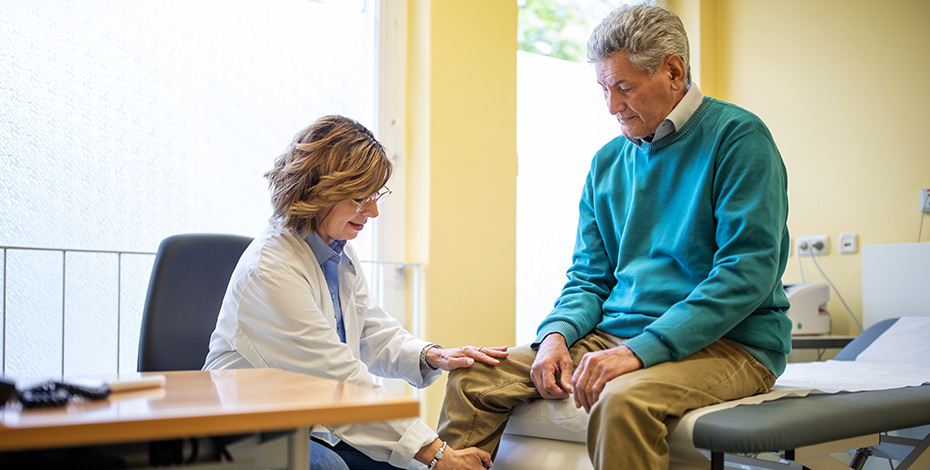
Tailored approaches to pain sensitivity

In the sixth instalment of our series on pain sensitivity, Darren Beales FACP and Tim Mitchell FACP provide further considerations for its management.
There is no recipe for the management of people whose pain sensitivity makes a significant contribution to their presentation.
But that’s okay because this is what makes our job interesting and rewarding.
Standard physiotherapy management practices (such as education, hands-on treatment and exercise) can all have hypoalgesic effects (make people feel immediately better) in some circumstances.
However, significant or dominant pain sensitivity might alter the effect of these treatments.
The hypoalgesic mechanisms of standard treatments might be faulty or less effective (but not always).
Therefore, flexibility in therapist skill might be required to manage people in this situation.
Help people make sense of their pain and pain sensitivity
The prior five articles in this series provide a framework for understanding and assessing pain sensitivity, detailed as a collaborative undertaking between the physiotherapist and the person with pain.
This allows the physiotherapist to explain the nature of the patient’s pain sensitivity (if it has been identified) in a way that is highly relevant to the person’s lived experience of their pain.
To be effective, the clinician, in consultation with the patient, needs to understand how the pain started and what factors may have influenced its maintenance, ensuring that this story makes sense in relation to the physical examination findings and other relevant information (including investigation findings).
As a clinician, you can estimate the level of pain sensitivity but the exact underlying cause (whether tissue-based or in the peripheral nervous system, the spinal cord and/or the brain) is not necessarily identifiable.
Testing tells us whether a person is sensitised but not where or how this is occurring.
Caution is therefore recommended in any initial explanation of sensitivity offered to the patient.
The physiotherapist should not claim certainty about the questionable or the tenuous.

Darren Beales.
In a person with an acutely sprained ankle and high sensitivity, there might be reasonable certainty that tissue-based sensitisation of peripheral nerve receptors is a dominant mechanism.
If a person has high sensitivity in an ankle after a sprain four months ago, then from a mechanistic standpoint, where in the system the sensitivity is maintained is more debatable.
Understanding sensitivity itself and how it is contributing to the person’s status may be much more important than a tenuous discussion of mechanisms.
We often find that direct experience during testing (eg, click here) coupled with simple explanations (eg, click here or here) is effective.
Furthermore, over-reliance on and overemphasis of tenuous underlying mechanisms of sensitivity can just confuse the patient (‘They told me the pain is in my head but I know there is something wrong in my back’).
Clinical tip—you know you are on track with this concept when, while summarising the person’s problems at the end of the consultation, they independently volunteer to you, ‘That makes sense.’
Identify factors that contribute to significant pain sensitivity
Firstly, these should be considered differently from underlying mechanisms. There are many factors associated with increased pain sensitivity.
Sex assigned at birth, age, obesity, smoking, medication use, mood and sleep might all be associated with results from pain sensitivity testing.
Some of these are modifiable but that does not mean you need to address all factors in every person, even if they are present.
It is the responsibility of the treating physiotherapist (in collaboration with the patient) to explore the relevance of any modifiable factor contributing to the patient’s presentation.
If their mood is worse, is their pain worse? If they have had a poor night’s sleep, is their pain worse the next day?
If yes, then considering the links between these factors and pain/pain sensitivity established by research, and taking into account clinical evidence you have collected during the assessment in collaboration with the person in pain, you may have identified worthwhile targets of a broad biopsychosocial approach.
To say that everyone with pain sensitivity needs neurophysiological education or needs psychological treatment for their mood or needs a sleep hygiene assessment is following a recipe.
It is not person-centred care and in many instances is unhelpful.
Once you have helped the person make sense of their pain and the factors contributing to their pain sensitivity, sometimes your job is almost done.
They can be empowered and find their way (click here for a story of pain sensitivity in a professional surfer).
Think about how you implement components of care
Components of care, initially at least, can be viewed as opportunities to desensitise the nervous system.
Exercise, activity and fun
Some form of physical activity is usually needed. Work out with the person what they want to engage in.
What are their priorities? What can they commit to? What will they stick with?
Once these fundamentals are agreed to, guidance on pacing the activity can be very important.
People with significant pain sensitivity may respond to physical activity dosage differently from those without this issue. For example, progression may be slower.
Their tolerance may be improved by carefully spreading exercise and/or activity across the day instead of pushing through thresholds in one session, which frequently winds the nervous system up further rather than desensitising it.
Some people can work out their own thresholds and quickly build from there. For others it can be a slow journey.
The importance of making this fun and enjoyable is not to be taken lightly.
Some people might have fun working out in the gym.
Others might prefer playing with their kids at the park or walking the dog with their partner or just being somewhere pleasant.
Focusing on the enjoyable side of building up activity tolerance can help with compliance. And most people find it hard to be depressed while having fun.
Desensitisation strategies
Approaches such as graded motor imagery may fit here. However, altered body perception is not a given with heightened pain sensitivity.
There is also no recipe for a body perception intervention. It doesn’t have to include specific laterality testing or mirror box treatment.
For some these might be useful, but other people with heightened pain sensitivity may have no problem with laterality.
Body scanning might be a useful strategy. Visualisation of problematic movements in the past and present can also help.

Tim Mitchell.
Whichever route you take, make sure the person understands why they are doing this and make it relevant to them.
A person with pain will quickly tire of an abstract activity if they do not understand why they are doing it.
If using specific desensitising treatments, you must do some kind of assessment that finds a deficit as proof of why it might help them and measure the effect (or not) of the intervention.
Tactile desensitisation may be helpful for some people—exposing the skin to different textures, pressures or sensations in order to normalise tactile senses.
Again, we would recommend careful pacing with these activities. Make sure they are helping.
Medicines
While it is not in the scope of the physiotherapist to prescribe medications for pain sensitivity, we can certainly ask the patient about their medication and whether it aligns with clinical practice guidelines for the use of medication for pain sensitivity.
If mismatches appear, then the person with pain should be directed to their GP to discuss this further (for some medication options, click here).
Multidisciplinary care
Multidisciplinary care may or may not be needed.
One practitioner with a clear, person-centred approach might be better than four with completely different opinions and approaches.
Four people with a shared approach might be overwhelming for some patients.
But when multiple healthcare practitioners are involved, every effort should be made to make sure that the team is on the same page and working towards a shared goal.
Engagement of the patients’ carers and/or family in this process may be very relevant.
Next time: Our last issue in this series will take the form of frequently asked questions. Contact us at education@painoptions.com.au if you have any questions.
Resources
Like to hear Tim and Darren casually chat about the management of pain sensitivity for musculoskeletal conditions? Click here.
Looking for case studies that consider pain sensitivity? Click here for Beales et al. ‘Masterclass: A pragmatic approach to pain sensitivity in people with musculoskeletal disorders and implications for clinical management for musculoskeletal clinicians.’ Musculoskeletal Science and Practice, 2021.
Click here for the Musculoskeletal Framework Team. Musculoskeletal Clinical Translation Framework, 2023.
Like something short and fun? (Tim and Darren again), click here.
>> Darren Beales FACP is a Specialist Musculoskeletal Physiotherapist (as awarded by the Australian College of Physiotherapists in 2008) and a director at Pain Options in Perth, WA. As a senior research fellow at Curtin University, Darren is undertaking broad research into clinical pain, from the mechanistic understanding of clinical pain to efforts to enhance the management of persistent pain and implementation of knowledge into practice.
>> Tim Mitchell FACP is a Specialist Musculoskeletal Physiotherapist (as awarded by the Australian College of Physiotherapists in 2007) and a director of Pain Options. Tim has completed a PhD in the area of low back pain and has a special interest in the translation of logical reasoning into clinical practice. He holds positions with the Australian Physiotherapy Council and the Australian College of Physiotherapists.
© Copyright 2024 by Australian Physiotherapy Association. All rights reserved.





